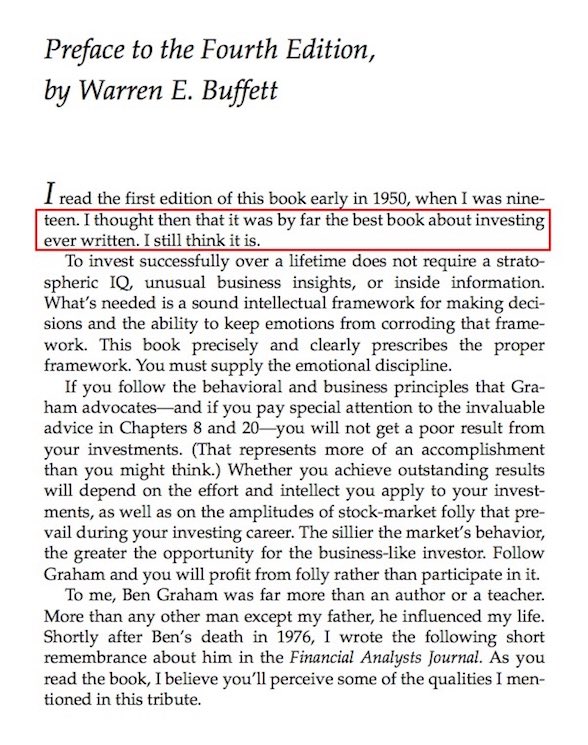√[22.5 x EPS x BVPS] is an Intrinsic Value investing formula that Benjamin Graham — Warren Buffett's mentor — did recommend, but with conditions.
Introduction
Benjamin Graham did recommend the Intrinsic Value calculation known today as the Graham Number. But as with most things related to Graham today, there's a big difference between how this calculation was recommended and how it's being used.
The Number
The Graham Number itself is simple enough, and can be derived from rule #6 and #7 of Graham's rules for Defensive stocks.
1. Not less than $100 million of annual sales.
2-A. Current assets should be at least twice current liabilities.
2-B. Long-term debt should not exceed the net current assets.
3. Some earnings for the common stock in each of the past 10 years.
4. Uninterrupted [dividend] payments for at least the past 20 years.
5. A minimum increase of at least one-third in per-share earnings in the past 10 years.
6. Current price should not be more than 15 times average earnings of the past three years.
7. Current price should not be more than 1½ times the book value.
As a rule of thumb, we suggest that the product of the multiplier times the ratio of price to book value should not exceed 22.5.
Note: The "multiplier" Graham refers to is simply another term for the P/E Ratio. Criterion #1 works out to $500 million today based on the increase in CPI / Inflation.
Mathematical Derivation
The optimum price for a Defensive grade stock can easily be derived from the last three lines above, and this price is known as the Graham Number.



![P * P < [22.5 * EPS * BVPS]](/sites/default/files/blog/GN4.gif)
Final Result
![Graham Number = √[22.5 x EPS x BVPS]](/sites/default/files/articles/beginners/GrNm.png)
Note: EPS(avg) is used here instead of plain EPS to indicate that the average of the past three years has been used, just as Graham required.
Versatility
The Graham Number is designed to assess stocks regardless of sector. Companies from low-earning industries such as Utilities will need higher asset figures, and those from low-asset ones such as Financial Services will need higher earning figures.
"It has long been the prevalent view that the art of successful investment lies first in the choice of those industries that are most likely to grow in the future and then in identifying the most promising companies in these industries... The author did not follow this approach in his financial career as fund manager, and he cannot offer either specific counsel or much encouragement to those who may wish to try it."
Common Misuses
The most common misuse of the Graham Number today is that it's used in isolation almost everywhere, while the five other supporting criteria for Defensive stock selection are completely ignored.
An online search for Graham Number will bring up dozens of analyst reports recommending stocks based on the Graham Number alone.
Graham Numbers are also rarely calculated using the average earnings of the past three years now, even though Graham gave detailed explanations of how easy it was to manipulate a single year's earnings figure and why such averaging was essential.
"The more seriously investors take the per-share earnings figures as published, the more necessary it is for them to be on their guard against accounting factors of one kind and another that may impair the true comparability of the numbers. We have mentioned three sorts of these factors: the use of special charges, which may never be reflected in the per-share earnings, the reduction in the normal income-tax deduction by reason of past losses, and the dilution factor implicit in the existence of substantial amounts of convertible securities or warrants... One important advantage of such an averaging process is that it will solve the problem of what to do about nearly all the special charges and credits."
Further Reading
For a complete understanding of stocks and investing, a reading of The Intelligent Investor by Benjamin Graham is highly recommended. This is the book that Warren Buffett himself describes — in his 1986 preface to it — as "by far the best book about investing ever written".
Conclusion
Graham's various sets of criteria are a fine balance of checks. There's no point if a stock meets just some of the criteria in a group and doesn't meet others. For example, it may be possible for a stock to show great Earnings figures while having too much Debt.
Using just a single year's Graham Number — which barely covers two of the seven Defensive criteria — is not only excessively simplistic, but also potentially dangerous.
Choosing stocks that completely meet one of Graham's other sets of criteria is a far better approach; rather than investing in stocks that incompletely meet the Defensive criteria. Graham did allow for individual exceptions though, if the portfolio as a whole cleared all criteria for Defensive investment.
Due to omissions in recent editions of The Intelligent Investor, a technique called the Benjamin Graham Formula is also often mistakenly used for stock valuation today.
Video: Graham Number
Buffett Likes Dividends
In the below clip from his address at the Berkshire Hathaway Annual Shareholders Meeting, Warren Buffett explains why he likes the stocks he owns to pay dividends and why Berkshire Hathaway hasn't paid any as yet.
Facebook Likes and Comments
Submitted by GrahamValue. Created on Saturday 7th July 2012. Updated on Wednesday 29th January 2025.


Comments
Thank you for thoughtful
Thank you for thoughtful reply. With your screener (amazing tool!), enterprising stocks are not harder to find than defensive. I can see that Graham criteria for the defensive-grade stocks are more stringent than for enterprising ones. Would it be correct to assume one must pay premium for the "safety margin" of the defensive stocks compared to enterprising ones? Thus the Defensive price is higher than Enterprising price? I am just trying to build an intuition here. Thanks!
A Reasonable Assumption
That would appear to be a reasonable assumption, nvladimus!
Defensive grade stocks have more stringent qualitative requirements, whereas Enterprising grade stocks have more stringent quantitative (price-dependent) requirements.
Modern technology does it make it easier to identify Enterprising grade stocks today; but such a portfolio requires more diversification, and therefore requires more maintenance effort as well.
Simple question. Now the
Simple question. Now the intrinsic value is exactly the same as the Graham number
But it must be compared (Graham's number) with the bond yield
This is called a satisfactory return. If I want to buy, I should buy on the margin of safety and look at a satisfactory return by their Graham number
Price vs Value
Dear Omar_H,
Thank you for your comment!
That's correct. The Intrinsic Value for Defensive grade stocks is the Graham Number, which would need to be adjusted for contemporary Bond Yields and Interest Rates.
The difference between the stock's price and this final appraisal value is the Margin of Safety.
Thank you again for your comment!
1- So the difference between
1- So the difference between the intrinsic value and ( Graham Number ) is the safety margin, a defensive stock.
2-Also, adventurous stocks, the same adventure?
3- What is the relationship of the "Intrinsic Value(%)"? Can you give me an example I don't understand? I appreciate your education
Responses
Dear Omar_H,
Thank you for your comment!
1. The Intrinsic Value for Defensive grade stocks is the same as the Graham Number.
2. If you mean "risk" by "adventure", please note that Graham advised against risky investments. Please see the quote at the end of this comment.
If you mean "Enterprising" by "adventure", please see the link above for the calculation of Enterprising Price (Serenity №).
3. Intrinsic Value(%) measures the Margin of Safety. So if a stock has an Intrinsic Value of $20 and its price is $10, its Intrinsic Value(%) is 200% and its Margin of Safety is 100%. Please see the link in the previous comment for details.
Thank you again for your comment!
2-I mean the difference
2-I mean the difference between the intrinsic value and graham number of the adventure stock is also the safety margin? Like Defensive Stocks?
Defensive and Enterprising
Dear Omar_H,
Thank you for your comment!
If you mean "Enterprising" by "adventure", please see the calculation of Enterprising Price (Serenity №) in the Quick Reference.
The Intrinsic Value for Defensive grade stocks is the Defensive Price (Graham №).
The Intrinsic Value for Enterprising grade stocks is the Enterprising Price (Serenity №).
Margin of Safety is the difference between stock price and Intrinsic Value.
Intrinsic Value(%) indicates a stock's Margin of Safety.
Please see the Quick Reference link above, and the tutorial videos in it, for a complete explanation of all terms.
Thank you again for your comment!